Glycopeptides, such as vancomycin, are critical in treating Gram-positive infections but can lead to infusion reactions ranging from mild to severe. Additionally, their use is associated with nephrotoxicity, which can manifest as increased serum creatinine or decreased glomerular filtration rate, particularly with prolonged or high-dose treatments. Furthermore, the emergence of resistance mechanisms against glycopeptides poses significant challenges in clinical management and treatment efficacy.
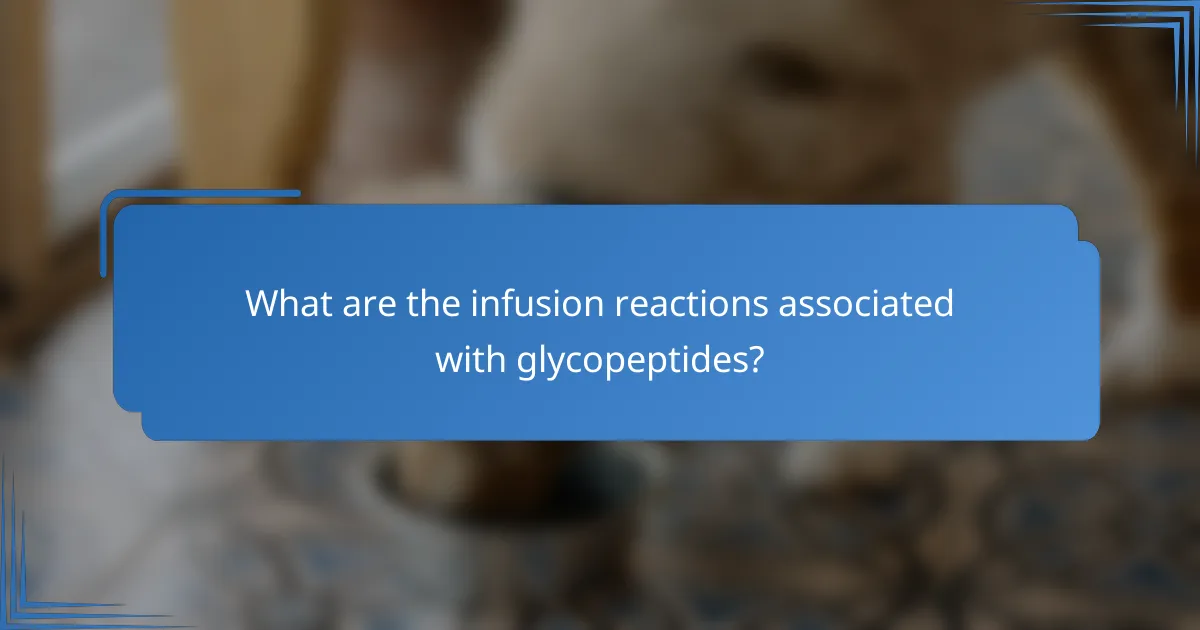
What are the infusion reactions associated with glycopeptides?
Infusion reactions to glycopeptides, such as vancomycin, can occur during or shortly after administration. These reactions may range from mild symptoms like flushing and rash to more severe manifestations, including hypotension and anaphylaxis.
Common infusion reactions
Common infusion reactions associated with glycopeptides include flushing, pruritus, and rash. Other symptoms can involve chills, fever, and hypotension. These reactions are often dose-dependent and can be exacerbated by rapid infusion rates.
Management strategies
To manage infusion reactions, it is recommended to slow the infusion rate or temporarily stop the administration of the glycopeptide. Pre-medication with antihistamines or corticosteroids may be beneficial for patients with a history of reactions. Continuous monitoring during infusion is crucial to promptly address any adverse effects.
Patient monitoring guidelines
Patients receiving glycopeptides should be monitored for signs of infusion reactions, particularly during the first dose. Vital signs should be checked regularly, and any symptoms of an adverse reaction should be documented and reported. It is advisable to observe patients for at least 30 minutes post-infusion to ensure their safety.
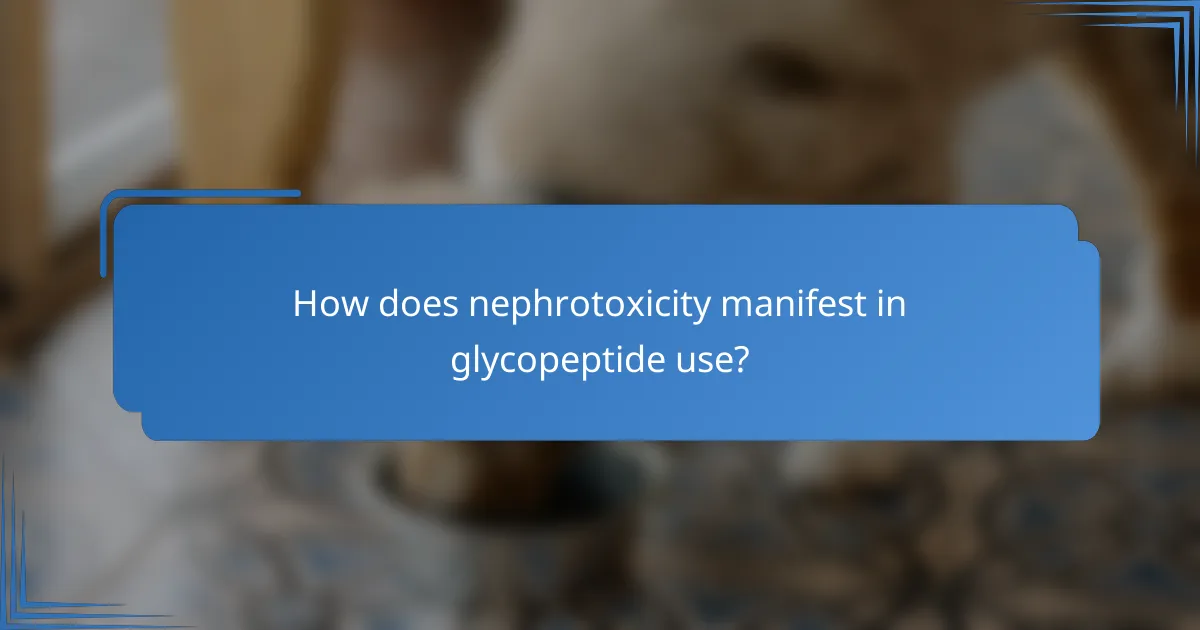
How does nephrotoxicity manifest in glycopeptide use?
Nephrotoxicity in glycopeptide use typically presents as an increase in serum creatinine levels or a decrease in glomerular filtration rate (GFR). This adverse effect can occur during treatment, particularly with prolonged use or higher doses, and may lead to acute kidney injury if not monitored properly.
Signs of nephrotoxicity
Common signs of nephrotoxicity include elevated serum creatinine levels, reduced urine output, and changes in electrolyte balance. Patients may also experience symptoms such as fatigue, swelling, or confusion, which can indicate worsening kidney function.
Monitoring renal function through regular blood tests is essential for early detection. A notable increase in creatinine levels, often exceeding 0.5 mg/dL from baseline, can be a critical indicator of nephrotoxicity.
Risk factors for nephrotoxicity
Several factors can increase the risk of nephrotoxicity when using glycopeptides. These include pre-existing kidney disease, concurrent use of other nephrotoxic medications, and dehydration. Elderly patients are particularly vulnerable due to age-related decline in renal function.
Additionally, high doses of glycopeptides or prolonged therapy can further elevate the risk. It is crucial to assess individual patient profiles to identify those at greater risk before initiating treatment.
Preventive measures
To minimize the risk of nephrotoxicity, healthcare providers should ensure adequate hydration before and during glycopeptide therapy. Adjusting the dosage based on renal function and closely monitoring kidney parameters can help prevent adverse effects.
Regular renal function tests should be performed, especially in high-risk patients. Educating patients about recognizing early signs of kidney issues can also empower them to seek timely medical advice if symptoms arise.
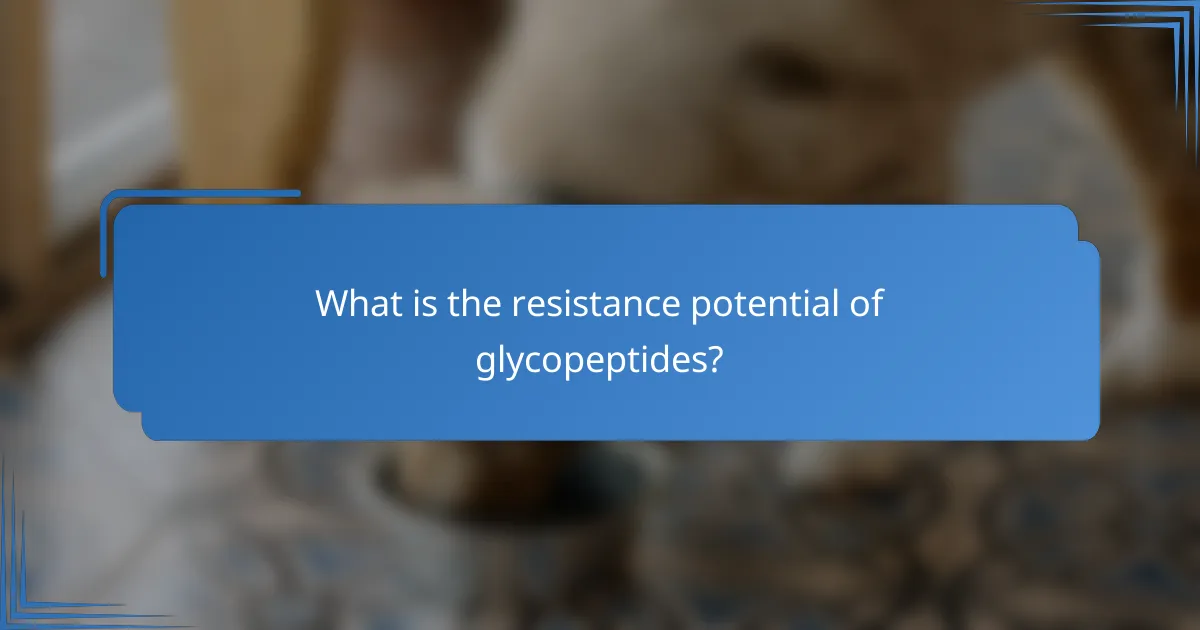
What is the resistance potential of glycopeptides?
The resistance potential of glycopeptides, primarily used to treat Gram-positive infections, is a growing concern in clinical settings. Resistance mechanisms can diminish their effectiveness, posing challenges for treatment outcomes and patient management.
Mechanisms of resistance
Resistance to glycopeptides often arises from genetic mutations in bacteria, particularly in the cell wall synthesis pathways. Key mechanisms include the alteration of target sites, such as the D-alanyl-D-alanine terminus, which reduces drug binding. Additionally, the emergence of vancomycin-resistant Enterococcus (VRE) exemplifies how bacteria can acquire resistance genes, complicating treatment options.
Another mechanism involves the production of enzymes that modify glycopeptides, rendering them ineffective. These resistance traits can spread through horizontal gene transfer, making it crucial to monitor and understand their prevalence in different regions.
Impact on treatment outcomes
The presence of glycopeptide resistance can significantly impact treatment outcomes, leading to prolonged infections and increased morbidity. Infections caused by resistant strains often require alternative therapies, which may be less effective or more toxic. This shift can also lead to higher healthcare costs due to longer hospital stays and the need for more complex treatment regimens.
Clinicians must consider local resistance patterns when selecting glycopeptide therapy, as resistance rates can vary widely by region and institution. Regular susceptibility testing is essential to guide appropriate antibiotic use and improve patient outcomes.
Current research findings
Recent research has focused on understanding the genetic basis of glycopeptide resistance and developing strategies to combat it. Studies are exploring novel antibiotics and combination therapies that may restore sensitivity to glycopeptides. For instance, some research indicates that combining glycopeptides with other agents can enhance their efficacy against resistant strains.
Additionally, ongoing surveillance of resistance patterns is critical. Research initiatives aim to track the emergence of resistance in various populations, informing guidelines and treatment protocols to mitigate the impact of glycopeptide resistance in clinical practice.

What are the best practices for glycopeptide administration?
Best practices for glycopeptide administration include careful dosing, adherence to infusion protocols, and consideration of compatibility with other medications. These practices help minimize adverse effects and enhance therapeutic efficacy.
Dosage recommendations
Dosage for glycopeptides typically depends on the specific drug, the patient’s weight, and the type of infection being treated. For instance, vancomycin is often dosed at around 15-20 mg/kg every 8-12 hours for serious infections, while teicoplanin may be given as a loading dose followed by maintenance doses.
Monitoring serum levels is crucial to avoid toxicity, especially in patients with renal impairment. Adjustments may be necessary based on renal function, with lower doses recommended for those with reduced clearance.
Infusion protocols
Infusion protocols for glycopeptides should aim to reduce the risk of infusion-related reactions, such as “red man syndrome.” Administering vancomycin over at least 60 minutes is generally recommended to minimize these reactions.
For patients at higher risk of adverse effects, premedication with antihistamines may be considered. Continuous monitoring during the infusion can help detect and manage any immediate reactions effectively.
Compatibility with other medications
Glycopeptides may interact with other medications, impacting their efficacy and safety. For example, combining vancomycin with nephrotoxic agents like aminoglycosides increases the risk of renal toxicity.
It’s essential to review a patient’s medication list for potential interactions. Using compatible intravenous solutions and ensuring proper flushing between medications can help mitigate risks during administration.
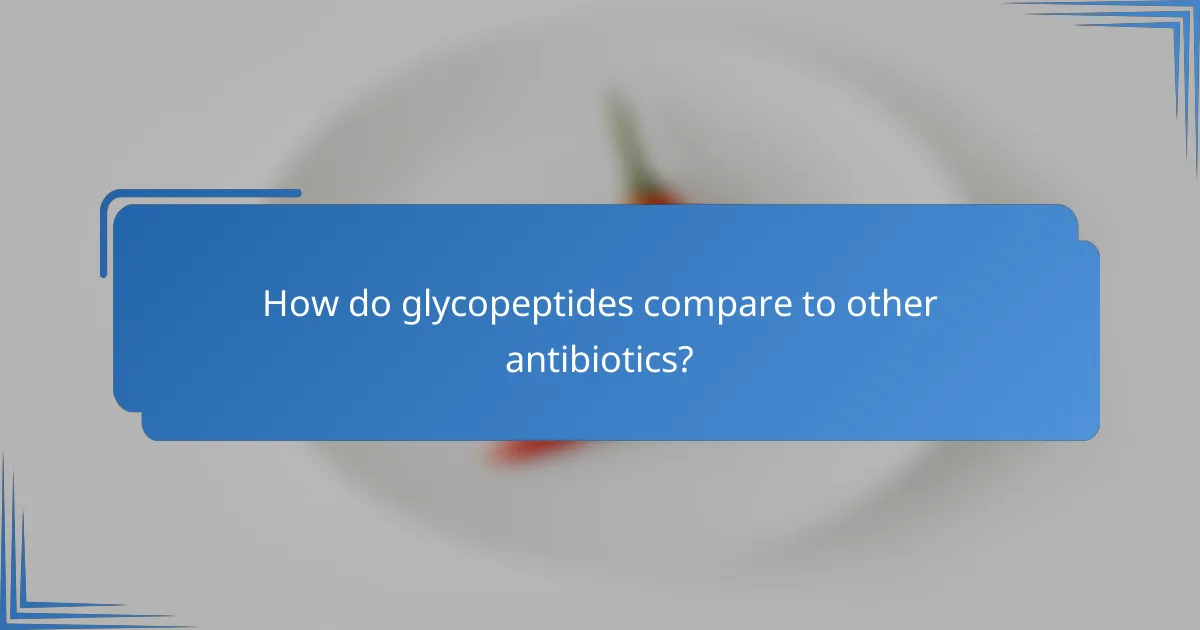
How do glycopeptides compare to other antibiotics?
Glycopeptides, such as vancomycin, are a unique class of antibiotics primarily effective against Gram-positive bacteria. They are often used when other antibiotics fail, particularly in cases of resistant infections.
Comparison with beta-lactams
Glycopeptides differ from beta-lactams in their mechanism of action; while beta-lactams disrupt bacterial cell wall synthesis by inhibiting penicillin-binding proteins, glycopeptides bind to the cell wall precursors, preventing their incorporation into the wall. This makes glycopeptides particularly effective against bacteria that produce beta-lactamases, which can render beta-lactam antibiotics ineffective.
In terms of spectrum, beta-lactams are generally broader, covering both Gram-positive and Gram-negative bacteria, whereas glycopeptides are more specialized. For instance, glycopeptides are often the go-to choice for treating methicillin-resistant Staphylococcus aureus (MRSA) infections.
Advantages over other classes
One significant advantage of glycopeptides is their efficacy against resistant strains of bacteria, particularly in serious infections where other antibiotics may fail. They are often used in hospital settings for severe infections caused by resistant Gram-positive organisms.
Additionally, glycopeptides have a relatively low incidence of cross-reactivity with penicillin allergies, making them a safer alternative for patients with such allergies. Their pharmacokinetics allow for both intravenous and oral administration, although oral forms are primarily used for gastrointestinal infections.
Limitations in treatment
Despite their advantages, glycopeptides have limitations, including potential nephrotoxicity, particularly with rapid infusion rates. Monitoring kidney function is essential during treatment to avoid complications.
Moreover, glycopeptides are not effective against Gram-negative bacteria, which limits their use in mixed infections. Resistance to glycopeptides is also emerging, necessitating careful consideration of their use in clinical practice.
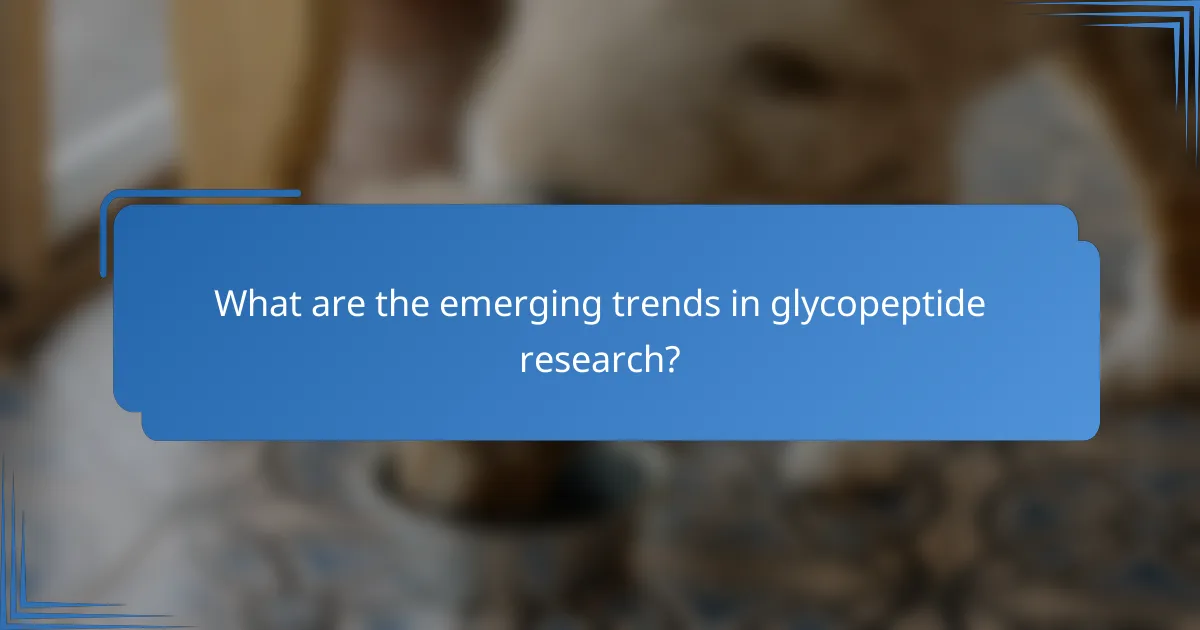
What are the emerging trends in glycopeptide research?
Emerging trends in glycopeptide research focus on understanding infusion reactions, nephrotoxicity, and resistance potential. Researchers are exploring ways to enhance efficacy while minimizing adverse effects and addressing the growing concern of antibiotic resistance.
Infusion reactions
Infusion reactions to glycopeptides can range from mild to severe, often manifesting as fever, chills, or rash. These reactions are typically dose-dependent and may occur more frequently with rapid infusion rates. Monitoring patients closely during administration can help mitigate these risks.
To reduce the likelihood of infusion reactions, healthcare providers often recommend administering glycopeptides slowly, over a period of at least 60 minutes. Pre-medication with antihistamines may also be beneficial for patients with a history of such reactions.
Nephrotoxicity
Nephrotoxicity is a significant concern with glycopeptide use, particularly in patients with pre-existing kidney conditions. The risk of kidney damage increases with higher doses and prolonged therapy, necessitating regular renal function monitoring.
To minimize nephrotoxicity, clinicians should adjust dosages based on renal function and consider alternative antibiotics when appropriate. Staying within recommended dosing guidelines can help reduce the risk of adverse renal effects.
Resistance potential
The potential for resistance to glycopeptides is an ongoing area of research, particularly with the rise of vancomycin-resistant organisms. Understanding the mechanisms of resistance is crucial for developing new strategies to combat these pathogens.
To address resistance, researchers are investigating combination therapies and novel glycopeptide derivatives that may retain efficacy against resistant strains. Continuous surveillance of resistance patterns is essential for guiding appropriate antibiotic use in clinical settings.
